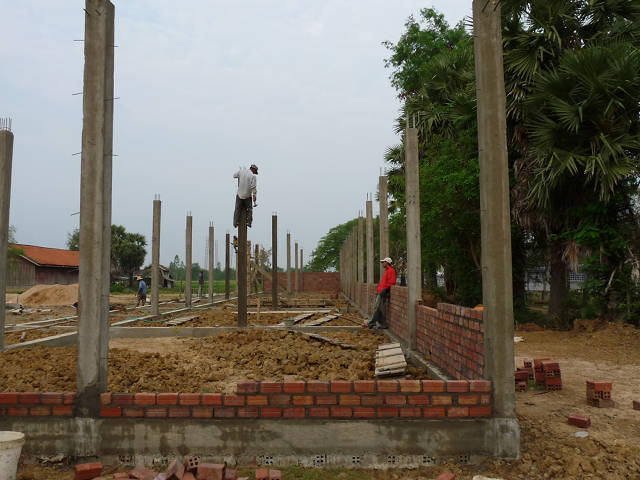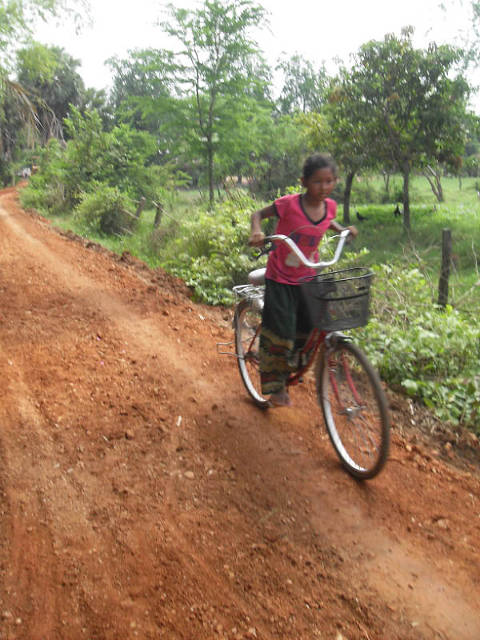Written by: Glenn Croston
http://www.fastcoexist.com
The
Cambodian Village Fund began as a simple gift of a bicycle to a village
that had no transportation. But that bicycle ended up turning into much
more.
When Bill and Nancy Bamberger from San Diego first visited
Cambodia as tourists in 2002, they were struck by its long history, the
warmth of its people, and the devastation that was still evident from
long years of violence and neglect. A whole generation of educated
people had been killed or fled the violence of the Khmer Rouge, holding
back the growth of Cambodia today. To help reverse that trend, the
Bambergers created the Cambodian Village Fund, supporting education in the rural village of Kaun Khlong.

The Bambergers’ 40th anniversary was approaching soon after they
returned to San Diego, when Nancy talked with her new hairdresser Chanra
Chheum, who was born in Cambodia and had come to the U.S. as a teenager
to escape the violence. Chanra had recently visited Kaun Khlong, where
she still had family, and had bought a bike for the village for $40.
There was little transportation there other than walking, and a simple
measure like a bike could make a difference for many. “People in the
village could share it. Kids could go to school and people could do
little errands,” said Bill when I talked with him. Forty dollars, 40th
anniversary; it was a sign. For their anniversary, Bill and Nancy
decided to buy the village a second bike.
A single bike may not sound like a big deal, but soon word spread
with their friends in San Diego who wanted to buy a bike for the village
as well. One thing lead to another and they had an anniversary party
with their friends. People bringing money for the fund rather than
bringing a gift, and the party collected $2,500 for the village. “It was
really a shock,” said Bill.

This was more than they had expected and the money went far in
Cambodia, buying bedding, blankets, food, mosquito nets, and bikes, and
uniforms for students, with another round of fundraising. When they went
to the village to help deliver the supplies, it was the first time they
had been there, and they thought at the time it would be the last. “We
thought it would be the end of it,” said Bill. It wasn’t.
“It was an amazing experience, a big celebration, and the kids are so
appreciative,” said Bill. “The mayor was there. There were speeches,
and when the kids went home, a school administrator walked with us to a
plot of land, and asked if we could help to fill the land, leveling it.
It would cost $4,500. We got home, talked to friends, and after eight
months or so had money to do the fill.” When the fill was done the next
step for the fund was a big one. “As soon as the fill was done, then
they asked if we could help build a school. We said we’d see what we
could do.”
This was the biggest project yet, but they managed to raise $20,000
and an interest-free $25,000 loan from a friend gave them enough to get
started on a five-room school in February 2011, finishing by October in
time for the kids coming back to school from summer.
As well as providing a good facility and a way for the students to
get there, Bill and Nancy found they needed to ensure the students could
keep going to school, so they created a scholarship program they called
Reach for the Sky. “We got started with a scholarship program, focused
on girls, because they are discriminated against,” said Bill. “A lot of
the girls aren’t able to go after 6th grade, because they work in the
fields or take care of families, just a little money keeps them in
school.” They’ve found that it takes a modest amount of money to keep
students in school, and that the students in the program serve as an
example for other children, encouraging them to stick with their
education as well. The scholarship program has expanded to include 17
girls now, including a few that have gone on to college, paid for by
their program. And still their work in the area continues to grow.
Education in rural areas like this is an important cause, but
unfortunately one that has been through controversy. Greg Mortenson, the
author of Three Cups of Tea, was a major figure in the cause of helping education around the world, until his claims about building schools in Pakistan and Afghanistan were discredited.
This failure doesn’t reduce the importance of education though, or
the opportunity to make a difference. To avoid such problems, the
Bambergers have posted all of their financials for anyone to see on
their website, and pay themselves nothing, taking great care to ensure
that every dollar is spent well, getting where it belongs, and going as
far as possible. The project is not about them, but the people they are
helping. They might not be able to change a whole country, but they can
make a difference one student, one school, and one village at a time.

1 comment:
Thank you may god bless you all involve with the project.
Post a Comment